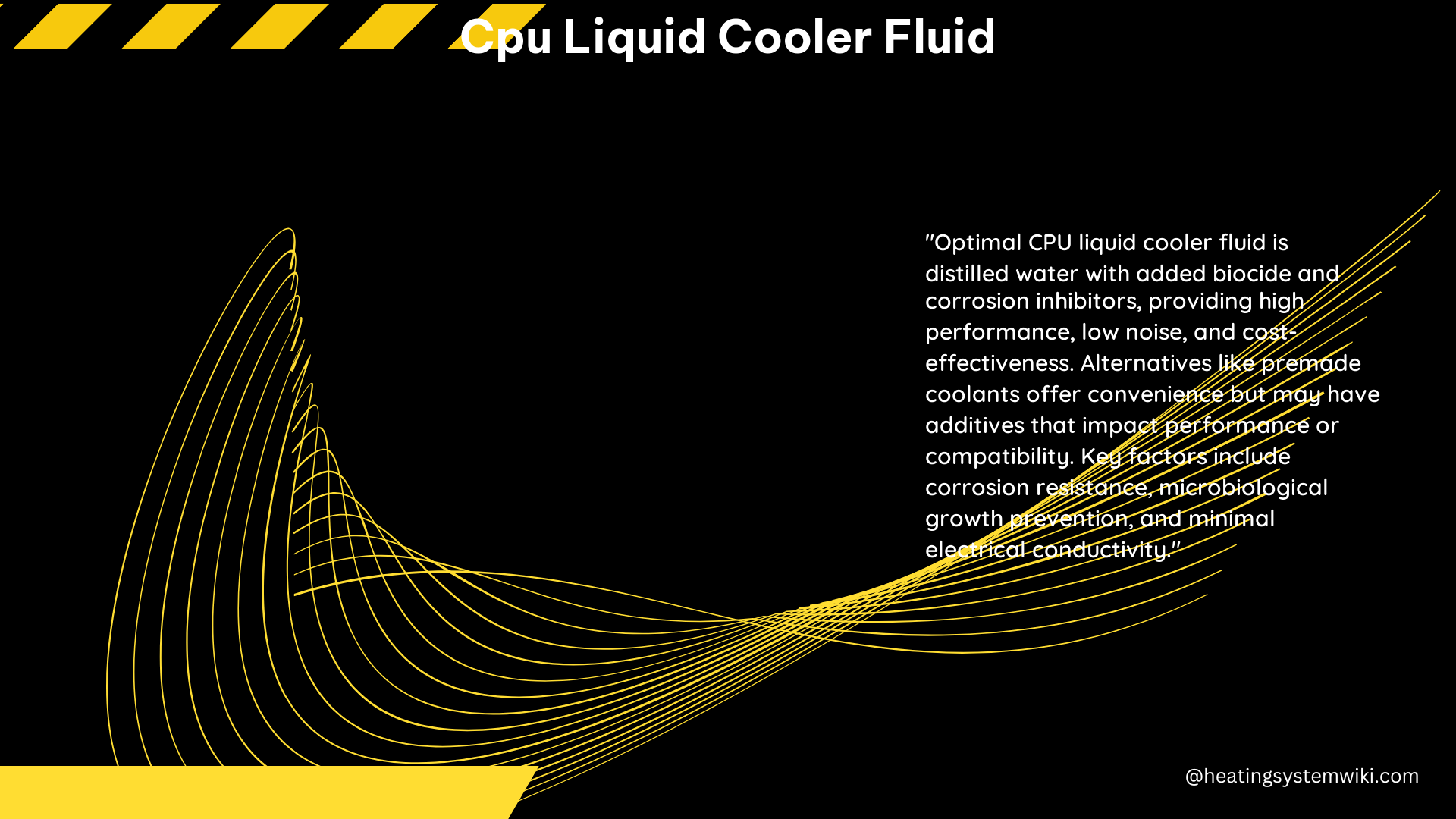When it comes to building a high-performance PC, the choice of CPU liquid cooler fluid is a critical decision that can significantly impact the overall system’s efficiency and lifespan. This comprehensive guide delves into the intricacies of CPU liquid cooler fluids, providing you with the technical knowledge and practical insights to make an informed decision for your system.
Understanding the Importance of CPU Liquid Cooler Fluid
The CPU, the heart of your computer, generates a significant amount of heat during operation. Effective cooling is essential to maintain optimal performance and prevent thermal throttling or even damage to the processor. CPU liquid cooler systems leverage the superior heat transfer properties of liquids to dissipate this heat efficiently, but the choice of coolant fluid can make all the difference.
Distilled Water: The Baseline Coolant

Distilled water is often considered the baseline coolant for CPU liquid cooling systems due to its excellent thermal properties and low cost. With a specific heat capacity of 4.18 J/g°C, distilled water can absorb and transfer heat effectively. Additionally, it is non-corrosive, making it a safe choice for most cooling components.
However, the lack of corrosion inhibitors and biocides in pure distilled water means that it is susceptible to the formation of algae, bacteria, and mineral buildup over time. These contaminants can clog the cooling system, reduce heat transfer efficiency, and even cause damage to the components. To mitigate these issues, it is crucial to regularly maintain the system and add the necessary additives to the distilled water.
Pre-Mixed Coolants: Convenience and Protection
Pre-mixed coolants, also known as ready-to-use or pre-diluted coolants, are specifically formulated for CPU liquid cooling systems. These coolants come with a blend of additives, including corrosion inhibitors and biocides, which help to protect the cooling components from degradation and microbial growth.
The primary advantage of pre-mixed coolants is their convenience. They eliminate the need for users to mix their own concoctions, reducing the risk of errors and ensuring compatibility with the cooling system’s materials. Additionally, pre-mixed coolants often contain specialized dyes or UV-reactive agents that can enhance the visual appeal of the cooling loop.
When selecting a pre-mixed coolant, it is essential to consider factors such as the coolant’s thermal performance, compatibility with the cooling system’s materials, and the manufacturer’s reputation for quality and reliability.
DIY Coolant Mixtures: Customization and Control
For those who prefer a more hands-on approach, DIY coolant mixtures offer the opportunity to customize the coolant to suit specific needs. By mixing distilled water with carefully selected additives, users can create a tailored coolant solution that addresses their system’s unique requirements.
The key to success with DIY coolant mixtures is thorough research and careful selection of compatible additives. Corrosion inhibitors, such as silicates, phosphates, or organic acids, are essential to protect the cooling system’s components from degradation. Biocides, like silver or copper-based compounds, help to prevent the growth of algae and bacteria.
When creating a DIY coolant mixture, it is crucial to ensure that the additives are compatible with the materials used in the cooling system, including the tubing, fittings, and the CPU water block. Incompatible additives can lead to corrosion, clogging, or even damage to the components.
Electrical Conductivity: A Critical Consideration
Regardless of the coolant choice, maintaining low electrical conductivity is essential to prevent damage to the system’s components. Minerals and impurities in the water can increase the coolant’s electrical conductivity, potentially causing short circuits or corrosion.
To ensure optimal electrical safety, it is recommended to use distilled or deionized water as the base for the coolant mixture. Additionally, regular testing and monitoring of the coolant’s electrical conductivity can help identify any issues before they become problematic.
Maintenance: The Key to Long-Term Performance
Proper maintenance is crucial for the longevity and performance of a CPU liquid cooling system. Regular flushing and refilling of the system with fresh coolant and additives can help prevent the buildup of contaminants, corrosion, and microbial growth.
The frequency of maintenance will depend on factors such as the type of coolant used, the system’s usage patterns, and the environment in which the PC is operated. As a general guideline, it is recommended to flush and refill the cooling system every 6 to 12 months, or as specified by the coolant manufacturer.
By following a consistent maintenance routine, users can ensure that their CPU liquid cooling system continues to operate at peak efficiency, protecting their investment and prolonging the lifespan of their high-performance components.
Conclusion
The choice of CPU liquid cooler fluid is a critical decision that can have a significant impact on the performance and longevity of your PC’s cooling system. Whether you opt for distilled water, pre-mixed coolants, or a DIY coolant mixture, it is essential to understand the technical considerations and maintain the system diligently.
By leveraging the insights and recommendations provided in this comprehensive guide, you can make an informed decision and ensure that your CPU liquid cooling system operates at its best, delivering reliable and efficient cooling for your high-performance computing needs.
